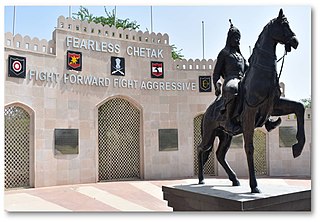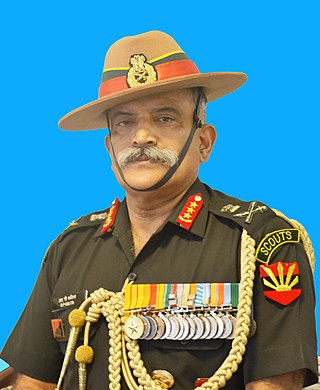History
First World War
Initially formed in December 1915, it took part in the Mesopotamian campaign under the command of Frederick Stanley Maude. In November 1916, it was split in two to form the I Corps and III Corps (also known as III (Tigris) Corps). [2]
Among its component divisions during World War I were the Cavalry Division, 3rd (Lahore) Division, 6th (Poona) Division, 7th (Meerut) Division, 12th Indian Division, 13th (Western) Division, 14th Indian Division, 17th Indian Division, and 18th Indian Division. [3]
From 1 January until 3 March 1917 the corps also commanded III (Tigris) Corps Cavalry Regiment, a composite unit comprising squadrons drawn from 1/1st Hertfordshire Yeomanry, 10th Lancers and 32nd Lancers. [3] [4] [5]
Second World War
The Indian III Corps was the primary ground formation that took part in the Malayan Campaign in 1942. It was commanded by Lieutenant-General Sir Lewis "Piggy" Heath.
Indian III Corps was formed in mid-1941 as part of the Malaya Command when the increase in tension in the Far East necessitated the dispatch of large reinforcements to the area to deter Japan. On 7 December 1941 the Corps consisted of the Indian 9th Infantry Division, commanded by Major-General Arthur Edward Barstow, the Indian 11th Infantry Division, commanded by Major-General David Murray-Lyon, a lines of communication Area, and the Penang Fortress. [6] Due to the rapid expansion of the British Indian Army, many of the formations in the Indian divisions were ill-trained and lacked large enough cadres of experienced troops.
The British had plans – Operation Matador and Operation Krohcol – to move forward into the south of Siam to forestall Japanese advances. However, lack of forewarning, combined with caution over upsetting Japan needlessly with precipitate actions, prevented the plans from being implemented. This put the garrison on the defensive, a position from which it never recovered.
III Corps was pushed down the Malayan peninsula by Japanese units, who employed novel tactics. When confronted with an Allied strong point on a road, the Japanese troops would leave a screen in front of the position, and then send infiltrators round through the jungle to outflank the position. Having been surrounded, positions were usually relatively easy to take. III Corps and the rest of the Allied land forces were pushed back to Singapore itself by February 1942. There they endured a short siege before the island surrendered at the direction of Lieutenant-General Arthur Ernest Percival. Some of the prisoners taken from Indian III Corps subsequently joined the Indian National Army.
Post independence
After the independence of India, a new III Corps was raised by the Indian Army on 4 February 1985 and is spread over the North Eastern States of Nagaland, Manipur, Mizoram, Tripura and Meghalaya. At the time of its formation, it consisted of 8 and 57 Mountain Divisions, under its command, in addition to troops of Assam Rifles. The 8 Mountain Division was moved out to Kashmir in 1990. [7]
The corps is presently based at Dimapur in north east India, and consists of three divisions being responsible for eastern Arunachal Pradesh and the Myanmar border. It is tasked for use in any future Indian war against China.
XV Corps, or 15 Corps, also known as Chinar Corps, is a Corps of the Indian Army which is presently located in Srinagar and responsible for military operations in the Kashmir Valley. It has participated in all military conflicts with Pakistan and China till date. Lieutenant General Rajiv Ghai is its current Corps Commander since 14 June 2023 taking over from Lieutenant General Amardeep Singh Aujla.
XXXIII Corps is a corps of the Indian Army. It draws some of its heritage from the British Indian XXXIII Corps which was formed in 1942, but disbanded in 1945. It was re-raised in 1960 at Shillong.
I Corps is a military field formation of the Indian Army. The Corps is headquartered at Mathura in Uttar Pradesh. It was raised on 1 April 1965. It was still being raised when it was despatched to the front in 1965. Raised as the First Strike Corps of the Indian Army, it was launched into operations in the Sialkot sector. The Corps conducted a counteroffensive during the Indo-Pakistani War of 1965. In the 1971 war against Pakistan, it took part in the Battle of Basantar.

Lieutenant General Krishna Mohan Seth retired as the Adjutant General of Indian Army and was the Governor of Chhattisgarh, Madhya Pradesh and Tripura.
The Indian Army had no standby force ready in 1971 with the specific task of attacking East Pakistan, one of the many reasons why India did not immediately intervene after Pakistan launched Operation Searchlight in March 1971. Indian Army's Eastern Command was tasked with defending the northern and eastern borders and fighting the insurgencies in Nagaland, Mizoram and Naxalites in West Bengal at that time.

The IV Corps, or the Gajraj Corps, is a military field formation of the Indian Army, covering the states of Assam and western Arunachal Pradesh.

II Corps is a corps of the Indian Army, based in Ambala and known as Kharga Corps.
9 Corps, also known as Rising Star Corps was raised in 2005 and is Indian Army's youngest corps

XIV Corps or Fire and Fury Corps is a corps of the Indian Army. It is a part of the Army's Udhampur-based Northern Command. The 14 Corps looks after military deployment along Kargil-Leh and looks after the frontiers with China, Pakistan and also guards the Siachen Glacier.

XXI Corps is a strike corps of the Indian Army and is headquartered at Bhopal.

X Corps is a corps of the Indian Army. It is based in Bathinda and is a part of South Western Command.

The Northern Command is a Command of the Indian Army. It was originally formed as the Northern Army of the British Indian Army in 1908. It was scrapped upon India's independence in 1947 and later re-raised in 1972. Currently, the XIV Corps (Leh), XV Corps (Srinagar), I Corps (Mathura) and XVI Corps (Nagrota) are under its control. Its present commander is Lieutenant General Upendra Dwivedi.

The XVI Corps is a corps of the Indian Army raised on 1 June 1972 with Lieutenant General J F R Jacob as its first General Officer Commanding (GOC). It has its headquarters at Nagrota Cantonment,, Jammu and Kashmir. In 2005, IX Corps was raised in southern part of the XVI Corps' area, taking over two of its divisions.

The Eastern Command is one of the six operational commands of the Indian Army. It is headquartered in Fort William in the city of Kolkata in the state of West Bengal. The Eastern Command was formed on 1 November 1920. The Command is commanded by a three-star rank officer with the title General Officer Commanding-in-Chief (GOC-in-C).

General Dalbir Singh Suhag, PVSM, UYSM, AVSM, VSM, ADC is the former Indian High Commissioner to Seychelles and a former Chief of Army Staff of the Indian Army. He was the 25th Chief of the Army Staff (COAS) of the Indian Army, serving from 31 July 2014 to 31 December 2016, and Vice Chief of the Army Staff prior to that.

Lieutenant General Kamal Jit Singh, PVSM, AVSM & Bar is a retired Indian Army officer and former general officer commanding-in-chief of Western Command. After retirement, he was conferred with Maharaja Ranjit Singh Chair of Excellence in Punjab University. and was appointed as Advisor to CM Haryana in November 2018. He graduated from the National Defence Academy, and attended various staff courses in training academies of the Indian Army throughout the country. Singh worked closely with UN Peacekeeping forces stationed in Angola and was commended by the chief and UN Force Commander during his tenure. He held several appointments as commanding officer and also staff appointments at the headquarters of the Indian Army. He has been twice awarded the Ati Vishisht Seva Medal. In 2019, Singh was appointed as State Information Commissioner and was inducted into Chandigarh Advisory Council. He was nominated as Chairman of Education Standing Committee of UT Advisory Council in 2022. He was awarded Ph D in Defence Studies in Oct 2023. He was conferred with designation of Honorary Professor in PU in Sep 23 and as Prof of Practice in Chandigarh University in Oct 23.
XVII Corps is the first mountain strike corps of India which has been built as a quick reaction force and as well as counter offensive force against China along LAC. Its headquarters are located at Panagarh in West Bengal under Eastern Command. It is also known as Brahmastra Corps.

Lieutenant General Abhay Krishna, PVSM, UYSM, AVSM, SM, VSM, ADC is a retired officer of Indian Army. He served as General Officer-Commanding-in-Chief (GOC-in-C), Central Command from 1 October 2018 following the retirement of Lieutenant General Balwant Singh Negi, to 30 September 2019. He was succeeded by Lieutenant General Iqroop Singh Ghuman. Prior to that, he commanded the Eastern Command and South Western Command of the Indian Army

Lieutenant General R Gopal, UYSM, AVSM, SM is a serving General Officer in the Indian Army. He retired as the Quarter Master General of the Indian Army. Previously, he commanded III Corps.

Lieutenant General Rana Pratap Kalita, PVSM, UYSM, AVSM, SM, VSM is a serving general officer in the Indian Army. He is currently the General Officer Commanding-in-Chief (GOC-in-C) of the Indian Army's Eastern Command. He previously commanded the III Corps at Dimapur.















